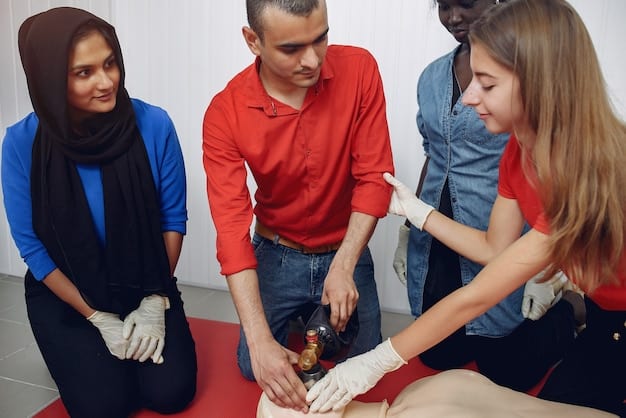CERT Training: Become a Certified Emergency Response Volunteer

Community Emergency Response Team (CERT) training empowers individuals to become certified volunteers prepared to assist their communities during emergencies by providing critical support in the immediate aftermath of disasters.
Are you looking for a way to give back to your community and make a real difference in times of crisis? Community Emergency Response Team (CERT) training offers you the opportunity to become a certified volunteer, equipped with the skills and knowledge to assist your neighbors and first responders during emergencies.
What is CERT Training?
Community Emergency Response Team (CERT) training is a nationally recognized program that prepares ordinary citizens to assist their communities in the event of a disaster. The program educates individuals about disaster preparedness and trains them in basic disaster response skills such as fire safety, light search and rescue, team organization, and disaster medical operations.
CERT volunteers supplement existing emergency responders to help save lives and protect property. By participating in a CERT program, you can gain the confidence and ability to assist others when professional responders are delayed or overwhelmed.
The Origins of CERT
The CERT concept originated in Los Angeles, California, in 1985. Recognizing the need for civilian assistance during major emergencies, the Los Angeles City Fire Department developed a training program to educate residents about disaster preparedness and basic response skills. The program was so successful that FEMA adopted it nationally in 1993.
The Core of CERT
CERT training encompasses several core modules designed to provide participants with a well-rounded skillset. These modules typically include disaster preparedness, fire safety, medical operations, light search and rescue, and team organization. Through hands-on exercises and realistic scenarios, volunteers learn how to effectively respond to a variety of disaster situations.

In conclusion, **Community Emergency Response Team (CERT) training** is a valuable program that empowers individuals to make a significant impact in their communities during times of crisis by providing them with skills-based training.
Benefits of Becoming a Certified CERT Volunteer
Becoming a certified CERT volunteer offers a multitude of benefits, both personal and community-oriented. Beyond the satisfaction of helping others, CERT training equips you with valuable skills, fosters community resilience, and provides opportunities for personal growth.
Participating in CERT training not only benefits you directly but also strengthens the overall preparedness and resilience of your community.
Skill Development and Personal Empowerment
CERT training provides you with a range of practical skills that can be applied both in disaster situations and in everyday life. These skills include basic first aid, fire suppression techniques, search and rescue methods, and communication protocols. By acquiring these skills, you gain confidence in your ability to handle emergencies and assist others in need.
Contributing to Community Resilience
By becoming a CERT volunteer, you contribute directly to the resilience of your community. In the event of a disaster, CERT volunteers can provide immediate assistance to their neighbors and support first responders, helping to save lives and minimize damage. A well-trained CERT team can significantly enhance a community’s ability to recover from a disaster.
- Enhance emergency preparedness skills.
- Contribute to community safety and resilience.
- Gain personal satisfaction from helping others.
- Network with community members.
In conclusion, becoming a certified CERT volunteer provides a multitude of benefits, ranging from acquiring essential skills to bolstering community resilience.
What to Expect During CERT Training
CERT training typically involves classroom instruction, hands-on exercises, and simulated disaster scenarios. The curriculum is designed to be accessible to individuals of all backgrounds and skill levels, with a focus on practical application and teamwork.
Although specific details vary slightly by location, the core components of CERT remains consistent across programs.
Curriculum Overview
CERT training is typically delivered over a period of several weeks, with each session focusing on a specific aspect of disaster preparedness and response. The curriculum covers topics such as disaster preparedness, fire suppression, medical operations, light search and rescue, team organization, and disaster psychology. Participants learn about the types of hazards that may affect their community, how to assess damage and injuries, and how to safely and effectively respond to a variety of disaster scenarios.
Hands-On Exercises and Drills
A key component of CERT training involves hands-on exercises and drills that allow participants to practice their skills in a safe and controlled environment. These exercises may include simulated fire scenarios, search and rescue operations, and medical triage exercises. Participants work together in teams to apply their knowledge and develop their problem-solving and decision-making abilities.

Ultimately, CERT training provides volunteers with the knowledge, skills, and confidence they need to respond effectively in a variety of disaster situations.
How to Find a CERT Program Near You
Finding a CERT program near you is relatively easy, thanks to the widespread availability of these programs across the United States. There are several resources available to help you locate a CERT program in your local area.
By taking advantage of these resources, you can easily find and enroll in a CERT program near you.
FEMA’s Website
The Federal Emergency Management Agency (FEMA) maintains a comprehensive database of CERT programs across the country. By visiting the FEMA website, you can search for CERT programs in your state or local area. The database provides contact information for each program, allowing you to easily reach out and inquire about upcoming training opportunities.
Your Local Emergency Management Agency
Your local emergency management agency is another valuable resource for finding CERT programs. These agencies often sponsor or coordinate CERT training in their communities. Contacting your local emergency management agency can provide you with information about upcoming training sessions and other CERT-related activities.
In conclusion, locating a CERT program nearby is simple thanks to FEMA and local emergency management agencies who are eager to help and respond to any questions.
Requirements for CERT Certification
While the specific requirements for CERT certification may vary slightly depending on the local program, there are some general guidelines that most CERT programs follow. These requirements ensure that CERT volunteers are well-prepared and qualified to assist in disaster response efforts.
Ensure that you meet the necessary requirements to become a fully certified CERT volunteer.
Attendance and Participation
Most CERT programs require participants to attend all training sessions and actively participate in exercises and drills. This ensures that volunteers receive a comprehensive understanding of the CERT curriculum and have the opportunity to practice their skills in a hands-on environment.
Background Checks and Clearances
Some CERT programs may require participants to undergo background checks or obtain clearances before becoming certified. This is particularly common for programs that involve working with vulnerable populations or in sensitive areas. Background checks help to ensure the safety and security of the community and the CERT program.
- Complete all required training modules.
- Pass any required exams or assessments.
- Undergo a background check.
- Meet any minimum age requirements.
Ultimately, certification as a member of **Community Emergency Response Team (CERT) training)** means that you’ve completed the necessary steps towards being a qualified and prepared volunteer to assist in any disaster response.
Maintaining Your CERT Certification
Once you have obtained your CERT certification, it is important to maintain your skills and knowledge through ongoing training and participation in CERT activities. This ensures that you remain prepared to assist in disaster response efforts and that your skills remain sharp and up-to-date.
Maintaining your CERT certification is an ongoing commitment that requires dedication and continuous learning.
Continuing Education and Drills
Most CERT programs offer continuing education opportunities for their volunteers, such as refresher courses, advanced training modules, and participation in drills and exercises. These activities help volunteers to stay up-to-date on the latest disaster response techniques and to practice their skills in a realistic setting.
Volunteer Activities and Deployments
Participating in CERT volunteer activities and deployments is another important aspect of maintaining your certification. This allows you to apply your skills in real-world situations and to gain valuable experience working alongside other CERT volunteers and first responders. Volunteer activities may include assisting with community events, providing traffic control during emergencies, or supporting shelters and distribution centers.
In conclusion, ongoing training and participation will maintain your CERT certification, ensuring that you are best prepared to serve your community.
| Key Point 🔑 | Brief Description |
|---|---|
| 📚 Core Skills | Learn basic disaster response skills like first aid and search & rescue. |
| 🤝 Community Impact | Assist your community during emergencies, enhancing local resilience. |
| 📍 Finding Programs | Locate local CERT programs through FEMA and emergency management agencies. |
What is CERT Training?
▼
What are the benefits of CERT Training?
The benefits of becoming a CERT Volunteer includes improved readiness in the event of a disaster and personal saftey.
What is needed to become certified?
▼
What can I expect in CERT training?
CERT training includes many things such as medical disaster training, fire safety, and search and rescue skills; each training consists of classroom lectures, demonstrations, and drills.
What are ways to find CERT programs nearby?
▼
What are some ways to maintain my certification?
Maintaining your certification is possible through ongoing volunteer training and participation in drills or real life volunteer activities.
In conclusion, Community Emergency Response Team (CERT) training and certification are not only avenues for personal growth but essential components of community resilience. By equipping individuals with critical skills and knowledge, CERT programs empower volunteers to assist their neighbors and support first responders during emergencies.
“; cursor: pointer; padding: 8px 16px; border-radius: 8px; display: inline-block; margin: 0 auto; text-align: center; white-space: nowrap; transition: background-color 0.3s ease; text-decoration: none;”>Read more content





